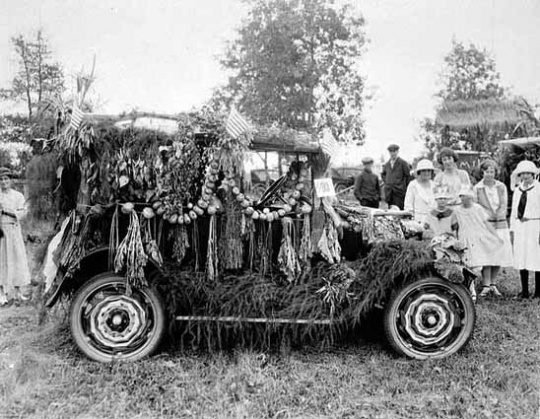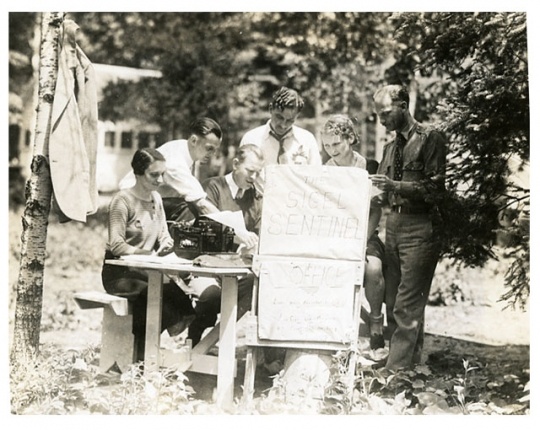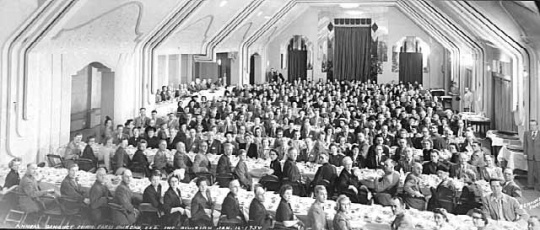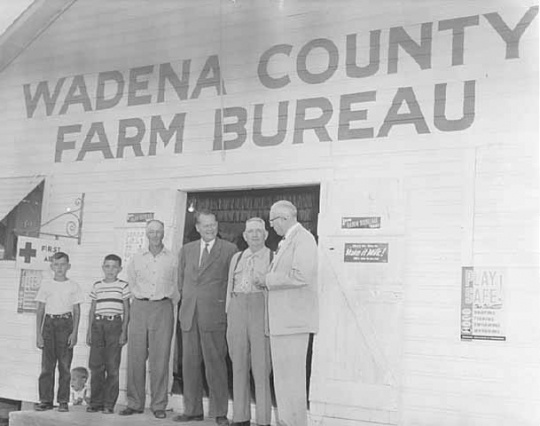Topics
Category
Era
Farm Bureau in Minnesota
Photograph of a parade float decorated with produce. The float was used in a Farm Bureau picnic parade to promote farming in St. Louis County, c. 1930.
When the farmers of Traverse County founded Minnesota's first Farm Bureau, it signaled a new movement in Minnesota agriculture. In the century since its creation, the Farm Bureau has worked on the local, state, and national levels to support farmers and act as the "voice of agriculture" in America.
The first Farm Bureau in the United States was founded in New York in 1911. Other states soon had bureaus of their own. These early groups formed in response to the growth of cities and industry in the early twentieth century. They offered education in agricultural science, sponsored community-building activities, and worked to improve rural Americans' quality of life. Their goal was to preserve the American farm and the farm family.
Minnesota's first Farm Bureau formed in Traverse County in 1913. Over the next few years, more counties, most in southwestern Minnesota, established their own bureaus. By 1917, there were over a dozen county bureaus in Minnesota.
Soon, the county bureaus chose to form a statewide group. In the autumn of 1919, farmers from across the state wrote an organizational charter. In November, Minnesota's county Farm Bureaus united to form the Minnesota Farm Bureau Federation (MFBF).
The original MFBF included twenty-four counties and had a membership of over sixteen thousand. Four months after its founding, the MFBF joined the new American Farm Bureau Federation. These new groups allowed the organization to act on both local and national levels.
The Farm Bureau quickly became a significant political force. Though its goals were dependent on the needs of local communities, the bureau worked to influence national agricultural policy. It supported rural electrification initiatives and improved roads and freight transportation. It helped farmers vaccinate livestock against disease. It also supported the Capper-Volstead Act, which allowed Minnesota farmers to form co-operatives (like Land-O-Lakes and the Wool Pool) without breaking anti-trust laws. County Farm Bureaus hosted dances, movies, and other social events for their communities.
MFBF bylaws stated that at least one seat on its state board of directors should be held by a woman. They also encouraged local boards to include women in leadership roles. Because their mission supported farms and farm life, the MFBF were quick to acknowledge the social, economic, and political importance of women. They offered classes for women in home economics, nutrition, and other domestic sciences, though rarely in agriculture.
The expanding power of the Farm Bureau was not always viewed in a positive light. As the organization grew more powerful, critics claimed that it spoke for large corporate interests instead of farmers. The Farm Bureau's opposition to minimum wage and anti-poverty legislation made it unpopular. The group also worked to discourage farm workers from unionizing. It was often in conflict with other farm organizations, including the Farmer's Union and Farmers' Holiday Association. Even its supporters acknowledged that it might not necessarily represent the interests of small farms.
In spite of this criticism, the MFBF remained active during the second half of the twentieth century. Members of the women's committee were ardent supporters of the Sister Kenny Institute. The MFBF supported the addition of ethanol into fuel blends. The Farm Bureau also gave Minnesotans, including former governor Al Quie, leadership experience within their communities and beyond.
In the early twenty-first century, MFBF has almost thirty thousand members. Seventy-eight of Minnesota's counties have a county Farm Bureau. The MFBF partners with the Minnesota State Fair to recognize Minnesota's Century and Sesquicentennial Farms-those that have been owned and operated by a family for a hundred or 150 years. The title of the Farm Bureau newspaper, the Voice of Agriculture, represents the role that the organization has played and continues to play in the lives of farm families across the nation.
Bibliography
Berger, Samuel R. Dollar Harvest: The Story of the Farm Bureau. Lexington, MA: Heath Lexington Books, 1971.
Berlage, Nancy K. "Organizing the Farm Bureau Family, Community, and Professionals, 1914–1928." Agricultural History 75, no. 4 (Autumn 2001): 406–437.
Minnesota Farm Bureau Federation. Twenty Years with the Minnesota Farm Bureau Federation. St. Paul: MFBF, 1940.
Minnesota Farm Bureau. What is the Minnesota Farm Bureau?
http://www.fbmn.org/pages/what-is-farm-bureau
Van Loh, Carolyn. Strong Roots: The People of the Minnesota Farm Bureau. Eagan, MN: Minnesota Farm Bureau Federation, 2008.
Related Resources
Primary
BB6.3 -M665
Correspondence, 1919 July–August. Minnesota Farm Bureau Federation
Manuscript Collection, Minnesota Historical Society, St. Paul
Description: Correspondence relating to the organization of the state and national Farm Bureau Federations.
HD 1485
Pamphlets Relating to Agricultural Societies in Minnesota, 1874–
Pamphlet Collection, Minnesota Historical Society, St. Paul
Description: Contains pamphlets and printed Farm Bureau materials.
OH 76
Minnesota Farm Economy Oral History Project: Interview with Gerald Hagaman
Oral History Collection, Minnesota Historical Society, St. Paul
http://collections.mnhs.org/cms/display.php?irn=10114926
Description: Oral history interview of Gerald Hagaman conducted by Margaret Robertson in St. Paul, Minnesota on November 22, 1989. Hagaman worked with the Farm Bureau on the local, state, and national levels. Full transcript is available online; cassettes are available at the MHS Library.
OH 76
Minnesota Farm Economy Oral History Project: Interview with Gloria Tepfer
Oral History Collection, Minnesota Historical Society, St. Paul
http://collections.mnhs.org/cms/display.php?irn=10308721
Description: Oral history interview of Gloria Tepfer, with comments by Wendy Tepfer Kluver, conducted by Margaret Robertson in Danube, Minnesota on April 11, 1989. Tepfer and her husband farmed outside of Danube, Minnesota, and Tepfer was active in farm organizations including the Renville County Farm Bureau. Full transcript is available online; cassettes and video recordings are available at the MHS Library.
Minnesota State Agricultural Society. Century Farm Applications, 1976–2009
State Archives, Minnesota Historical Society, St. Paul
http://www.mnhs.org/library/findaids/gr00094.xml
Description: Application forms for residents who wished to have their farms declared century farms, signifying that the farm had been in the same family for 100 or more years. The Minnesota Farm Bureau Federation eventually co-sponsored the project.
Kramer, Dale. Truth About the Farm Bureau. St. Paul: Farmers Book Store, 1938.
Secondary
"7,439 and Counting: Century Farms Honor Minnesota's Agricultural Heritage." Minnesota History Interpreter 29, no. 4 (May 2001): 1–2.
http://www2.mnhs.org/about/publications/interpreter/may2001.pdf
Campbell, Christiana McFadyen. The Farm Bureau and the New Deal: A Study of the Making of National Farm Policy, 1933–40. Urbana: University of Illinois Press, 1962.
Kile, Orville Merton. The Farm Bureau through Three Decades. Baltimore: Waverly Press, c. 1948.
Lindstrom, David Edgar. American Farmers and Rural Organizations. Edited by Herbert McNee Hamlin. Champaign, IL: The Garrard Press, 1948.
McConnell, Grant. The Decline of Agrarian Democracy. Berkeley: University of California Press, 1953.
Related Images

Farm Bureau parade float
Photograph of a parade float decorated with produce. The float was used in a Farm Bureau picnic parade to promote farming in St. Louis County, c. 1930.
Holding Location
Articles
More Information

St. Louis County Farm Bureau Institute
Photograph of the St. Louis County Farm Bureau Institute's daily news staff, 1929.
Holding Location
Articles
More Information

Minnesota Farm Bureau banquet
Photograph of the annual banquet of the Minnesota Farm Bureau Federation, Insurance Division held at the Lowery Hotel in St. Paul on January 16, 1950. Photograph by Schwang.
Holding Location
Articles
More Information

Val Bjornson
Photograph of Val Bjornson in front of Wadena County Farm Bureau Building with Joe Langer, Fred Miller and others, c. 1954.
Holding Location
Articles
More Information
Related Articles
Turning Point
In November of 1919, the Minnesota State Farm Bureau Federation is organized.
Chronology
1913
1914
1919
1919
Bibliography
Berger, Samuel R. Dollar Harvest: The Story of the Farm Bureau. Lexington, MA: Heath Lexington Books, 1971.
Berlage, Nancy K. "Organizing the Farm Bureau Family, Community, and Professionals, 1914–1928." Agricultural History 75, no. 4 (Autumn 2001): 406–437.
Minnesota Farm Bureau Federation. Twenty Years with the Minnesota Farm Bureau Federation. St. Paul: MFBF, 1940.
Minnesota Farm Bureau. What is the Minnesota Farm Bureau?
http://www.fbmn.org/pages/what-is-farm-bureau
Van Loh, Carolyn. Strong Roots: The People of the Minnesota Farm Bureau. Eagan, MN: Minnesota Farm Bureau Federation, 2008.
Related Resources
Primary
BB6.3 -M665
Correspondence, 1919 July–August. Minnesota Farm Bureau Federation
Manuscript Collection, Minnesota Historical Society, St. Paul
Description: Correspondence relating to the organization of the state and national Farm Bureau Federations.
HD 1485
Pamphlets Relating to Agricultural Societies in Minnesota, 1874–
Pamphlet Collection, Minnesota Historical Society, St. Paul
Description: Contains pamphlets and printed Farm Bureau materials.
OH 76
Minnesota Farm Economy Oral History Project: Interview with Gerald Hagaman
Oral History Collection, Minnesota Historical Society, St. Paul
http://collections.mnhs.org/cms/display.php?irn=10114926
Description: Oral history interview of Gerald Hagaman conducted by Margaret Robertson in St. Paul, Minnesota on November 22, 1989. Hagaman worked with the Farm Bureau on the local, state, and national levels. Full transcript is available online; cassettes are available at the MHS Library.
OH 76
Minnesota Farm Economy Oral History Project: Interview with Gloria Tepfer
Oral History Collection, Minnesota Historical Society, St. Paul
http://collections.mnhs.org/cms/display.php?irn=10308721
Description: Oral history interview of Gloria Tepfer, with comments by Wendy Tepfer Kluver, conducted by Margaret Robertson in Danube, Minnesota on April 11, 1989. Tepfer and her husband farmed outside of Danube, Minnesota, and Tepfer was active in farm organizations including the Renville County Farm Bureau. Full transcript is available online; cassettes and video recordings are available at the MHS Library.
Minnesota State Agricultural Society. Century Farm Applications, 1976–2009
State Archives, Minnesota Historical Society, St. Paul
http://www.mnhs.org/library/findaids/gr00094.xml
Description: Application forms for residents who wished to have their farms declared century farms, signifying that the farm had been in the same family for 100 or more years. The Minnesota Farm Bureau Federation eventually co-sponsored the project.
Kramer, Dale. Truth About the Farm Bureau. St. Paul: Farmers Book Store, 1938.
Secondary
"7,439 and Counting: Century Farms Honor Minnesota's Agricultural Heritage." Minnesota History Interpreter 29, no. 4 (May 2001): 1–2.
http://www2.mnhs.org/about/publications/interpreter/may2001.pdf
Campbell, Christiana McFadyen. The Farm Bureau and the New Deal: A Study of the Making of National Farm Policy, 1933–40. Urbana: University of Illinois Press, 1962.
Kile, Orville Merton. The Farm Bureau through Three Decades. Baltimore: Waverly Press, c. 1948.
Lindstrom, David Edgar. American Farmers and Rural Organizations. Edited by Herbert McNee Hamlin. Champaign, IL: The Garrard Press, 1948.
McConnell, Grant. The Decline of Agrarian Democracy. Berkeley: University of California Press, 1953.





